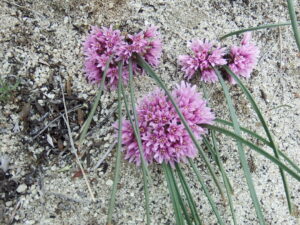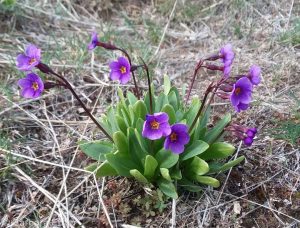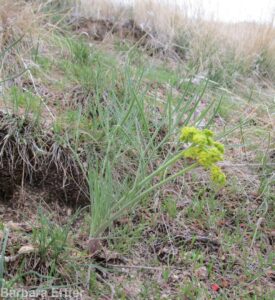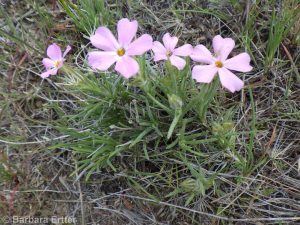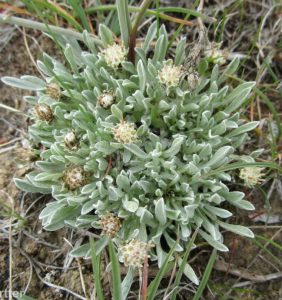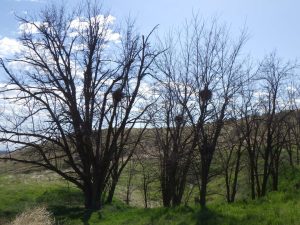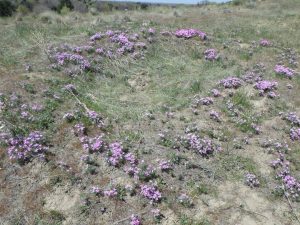BUENA VISTA TRAIL WILDFLOWER WALK
mid March to early April
For a good selection of early blooming spring flowers, including a couple of our rarest species, the Buena Vista loop in Hillside to Hollow Reserve is hard to beat! The route described here circumnavigates the upper slopes of the western ridge, traversing some of the best remaining good-quality habitat on both south- and north-facing slopes in the lower Foothills. Special plants for this trail include a large population of Aase’s onion (Allium aaseae) on the upper south-facing slopes. This is also the best trail for our only native true primrose, Cusick’s primrose (Primula cusickiana), which is one of the earliest flowers to bloom locally. A few small patches can be spotted in late winter/early spring on upper north-facing slopes.
NOTE: Please enjoy the wildflowers and leave them for others to enjoy. Because our unique local flora is already under pressure from invasive weeds and habitat loss, this website does not encourage the harvesting of native plants, especially along popular trails, and rare plants in particular should be given the best chance possible to continue existing in the wild, where everyone can enjoy them.
Description: Counter-clockwise on Buena Vista Trail from West Climb Trail in Hillside to Hollow Reserve (Ussery or Hillside trailheads). Full loop requires trail-only access through private land. Difficulty: 2-3 miles roundtrip, 130 feet elevation gain. Avoid when muddy!
The loop for this walk can be accessed at various points from multiple trailheads in the Hillside to Hollow Reserve, but to get to the “good stuff” as quickly as possible the route described here starts from the small trailhead at the end of Ussery Street on the north side of Hill Road. It also goes counter-clockwise for the same reason, but the reverse direction is recommended if crossing the muddiest sections while they are still frozen in the early morning is a priority.
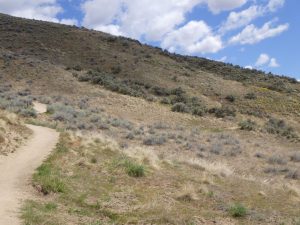
From the Ussery trailhead, head north on West Climb Trail (#55), which is an old road lined with feral rye (Secale cereale) and other invasive non-natives. Either turn right on Robert Smylie Trail (#54), then left on the short connector to Buena Vista Trail (#53), or stay on West Climb Trail until reaching the Buena Vista Trail; the latter option is more likely to be muddy. Go east on the Buena Vista Trail as it traverses the sandy south side of the ridge, with occasional switchbacks going higher up. As you go up in elevation, note how the solid stands of weedy grasses and other non-natives give way to an open matrix of sandy “bare” ground (actually a complex micro-ecosystem) that provides habitat for a diversity of bunchgrasses, perennial forbs, and tiny annual wildflowers (mostly non-native, but still cute!) Native wildflowers that are most likely to be in bloom in early spring include woollypod milkvetch (Astragalus purshii var. glareosus), narrow-leaf biscuitroot (Lomatium simplex), and prickly phlox (Phlox aculeata), soon to be joined by arrowleaf balsamroot (Balsamorhiza sagitatta).

Once you start encountering areas with lots of “bare” sandy habitat, start keeping an eye out for clusters of pink flowers scattered on the ground, with a couple of sprawling grasslike leaves per cluster. These are the lovely Aase’s onion (Allium aaseae), among the rarest of all plants most of you will ever see growing in the wild. Although relatively common at this particular locality, the species’ worldwide distribution is limited to sandy areas in the foothills from Boise to Weiser, so be sure to stay on the trail and avoid disturbing this special plant. If your timing is right, the few you spot at first will become increasingly abundant, with the main population where the trail wraps around to the east side of the ridge.

After traversing the steep east-facing slope, the Buena Vista trail intersects a six-way junction at the saddle between the east and west peaks of the ridge. Take the lower of the options heading west, so as to traverse as much of the north-facing side of the ridge as possible. With luck, you might spot some sagebrush buttercup (Ranunculus glaberrimus), most likely on the slope well below the trail, tiny flowers nestled among mats of dwarf pussytoes (Antennaria dimorpha), and even some more Aase’s onion. This segment of trail soon doubles back and briefly reconnects with Kemper’s Ridge Trail (#52) that climbs straight up the ridge; stay on the Buena Vista Trail when it immediately branches to the right.
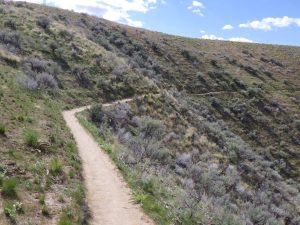
You are now traversing some of the highest quality north-facing habitat in the central Foothills, where many previously comparable ridges have been scalped and converted into coveted view lots. Note the differences from the previously traversed south-facing slope: fine loamy soil (muddy when wet!), an abundance of mosses and lichens covering the “bare” matrix, and a corresponding different suite of flowers (with some overlap).
With good timing and luck, you will be able to spot some Cusick’s primrose (Primula cusickiana) in bloom in one of the small populations scattered along the trail. This is our only locally native true primrose, not to be confused with unrelated evening-primroses (Oenothera). Although not considered as globally rare as Aase’s onion, with a range extending from the Blue Mountains of Oregon to central Idaho, Cusick’s primrose is much harder to find in the Boise Front, and is often finished blooming before Aase’s onion even gets started. This stretch of trail is in fact one of the only trails, and certainly the easiest, to see this charming little plant in the Ridge to Rivers trail network. Unfortunately, it is also EXTREMELY vulnerable, especially when the steep slopes are so saturated that even a dog running happily off path can cause serious damage. Be sure to stay on the path on this section of the trail, or turn back if muddy, no matter how tempted you might be to do otherwise.

The official Buena Vista Trail ends at the next saddle, but a selection of trails continues into the private land at the west end of the ridge. Behave respectfully, and hopefully public access will continue to be allowed, preserving the intactness of the ridge and making the full loop possible. If possible, stay to the right, traversing the final stretch of north-facing slope that harbors a few more Cusick’s primrose, which sometimes bloom a bit earlier here than elsewhere.
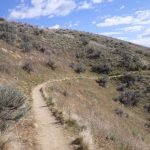
Once the side trail reconnects with the main trail, the recommended route is to continue following the ridge down past a neighborhood connecting trail to the right and then past a well-used but steep short-cut to the left. Turn left instead on the next trail that doubles back to traverse an east-facing slope with abundant sagebrush overlooking the Quail Hollow golf course. Although not as rich in spring flowers as other parts of the loop, this is a good stretch to enjoy other species as the season progresses, in reasonably intact habitat.
After this stretch ends by rejoining the steep short-cut from the ridge, take whichever route catches your fancy to return to the Ussery trailhead. The shortest route is the steep drop back into the draw, or you can stay on the ridge a bit longer to re-enter public lands and a choice of more gradual descents. Either the short route or left on Buena Vista trail take you into the draw near an old homestead site with non-native black locust trees (Robinia pseudo-acacia) harboring bulky magpie nests; take time to also admire the lichens that grace the former stonework strewn around. Alternatively, you can prolong your hike by continuing straight on Buena Vista trail before returning to Ussery by turning left on Full Sail Trail (#56). Whatever route you choose, be sure to enjoy your hike, and whatever wildflowers you see!

WILDFLOWERS POTENTIALLY IN BLOOM
(* indicates native species)
Plants listed in approximate order of encounter within category.
- *Woolly-pod milkvetch (Astragalus purshii var. glareosus)
- Spring whitlow-grass (Draba verna) – tiny white flowers with notched petals, non-native
- Jagged chickweed (Holosteum umbellata) – inconspicuous non-native
- Stork- or cranesbill, filaree (Erodium cicutarium) – non-native
- Desert alyssum (Alyssum desertorum) – widespread non-native
- Clasping pepperweed (Lepidium perfoliatum) – non-native
- *Bulbous or pink woodlandstar/prairiestar (Lithophragma glabrum, previously L. bulbiferum)
- *Narrowleaf or Great Basin biscuitroot (Lomatium simplex, previously included in L. triternatum, nine-leaf biscuitroot)
- *Prickly-leaf phlox (Phlox aculeata)
- *Arrowleaf balsamroot (Balsamorhiza sagittata)
- *Aase’s onion (Allium aaseae) – rare regional endemic, locally abundant on this trail
- *Dwarf or low pussytoes (Antennaria dimorpha)
- *Sagebrush buttercup (Ranunculus glaberrimus) – can begin blooming in February
- *Foothill or peak saxifrage (Micranthes/Saxifraga nidifica)
- *Cusick’s or Wilcox’s primrose (Primula cusickiana var. cusickiana) – localized and rare
- *Tansymustard (Descurainia sp.) – native species difficult to distinguish, taxonomy in flux
TREES AND SHRUBS (not in bloom)
- Black locust (Robinia pseudoacacia) – non-native tree
- *Big sagebrush (Artemisia tridentata subsp. tridentata)
- *Rubber rabbitbrush (Ericameria [formerly Chrysothamnus] nauseosa) — var. hololeuca is the more common larger variety; the smaller, more spindly var. oreophila is mostly on plateaus
SIGNIFICANT NOXIOUS WEEDS (not in bloom, but evident)
- Feral or Cereal Rye(Secale cereale)
- Rush skeletonweed (Chondrilla juncea)
- Medusahead grass (Taeniatherum/Elymus caput-medusae)
- Cheatgrass (Bromus tectorum) — other annual Bromus also present
- St. Johnswort, Klamathweed(Hypericum perforatum)
PRIMARY BUNCHGRASSES (mostly not in bloom, but evident)
- *Threeawn grass (Aristida purpurea var. longiseta)
- *Squirreltail grass (Elymus elymoides, formerly Sitanion hystrix)
- *Bluebunch wheatgrass (Pseudoroegneria spicata, alternatively in Agropyron or Elymus)
- Bulbous bluegrass (Poa bulbosa) – weedy non-native
- *Sandberg bluegrass (Poa secunda)
